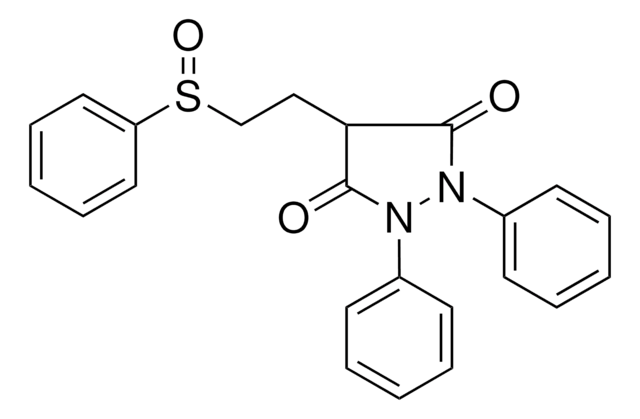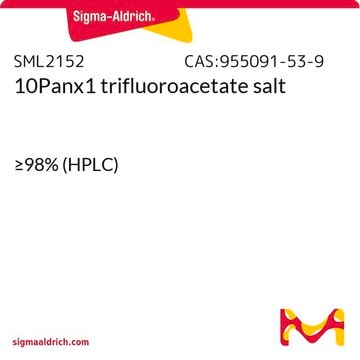P8761
Probenecid
≥98% (NaOH, titration), powder, uricosuric agent
Synonym(s):
p-(Dipropylsulfamoyl)benzoic acid
About This Item
Recommended Products
product name
Probenecid,
Assay
≥98% (NaOH, titration)
originator
Merck & Co., Inc., Kenilworth, NJ, U.S.
SMILES string
CCCN(CCC)S(=O)(=O)c1ccc(cc1)C(O)=O
InChI
1S/C13H19NO4S/c1-3-9-14(10-4-2)19(17,18)12-7-5-11(6-8-12)13(15)16/h5-8H,3-4,9-10H2,1-2H3,(H,15,16)
InChI key
DBABZHXKTCFAPX-UHFFFAOYSA-N
Gene Information
human ... SLC22A11(55867) , SLC22A6(9356) , SLC22A8(9376)
Looking for similar products? Visit Product Comparison Guide
Application
- as a component of phenol red free Hank′s buffer for Intracellular Ca2+-mobilization assay
- as a component of calcium sensitive dye for calcium mobilization Studies
- as a supplement in Hank′s balanced salt solution (HBSS) assay buffer
Biochem/physiol Actions
Features and Benefits
Signal Word
Warning
Hazard Statements
Precautionary Statements
Hazard Classifications
Acute Tox. 4 Oral
Storage Class Code
11 - Combustible Solids
WGK
WGK 3
Flash Point(F)
Not applicable
Flash Point(C)
Not applicable
Personal Protective Equipment
Certificates of Analysis (COA)
Search for Certificates of Analysis (COA) by entering the products Lot/Batch Number. Lot and Batch Numbers can be found on a product’s label following the words ‘Lot’ or ‘Batch’.
Already Own This Product?
Find documentation for the products that you have recently purchased in the Document Library.
Customers Also Viewed
Articles
Protein-based drug transporters are expressed in Sf9 cells. Understanding the specific mechanisms of tumor cell transporters is an essential aspect of chemotherapeutic drug design.
Protein-based drug transporters are expressed in Sf9 cells. Understanding the specific mechanisms of tumor cell transporters is an essential aspect of chemotherapeutic drug design.
Protein-based drug transporters are expressed in Sf9 cells. Understanding the specific mechanisms of tumor cell transporters is an essential aspect of chemotherapeutic drug design.
Protein-based drug transporters are expressed in Sf9 cells. Understanding the specific mechanisms of tumor cell transporters is an essential aspect of chemotherapeutic drug design.
Our team of scientists has experience in all areas of research including Life Science, Material Science, Chemical Synthesis, Chromatography, Analytical and many others.
Contact Technical Service
















